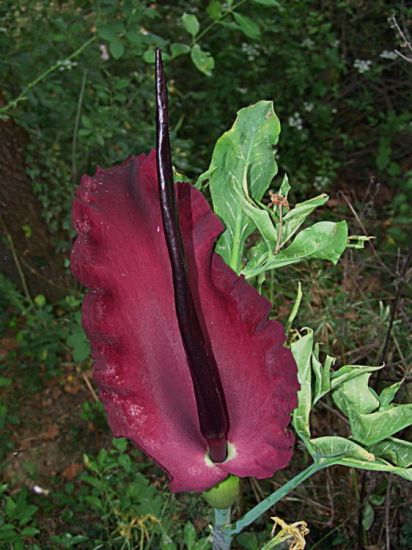I've been rather interested in strange botany recently. Particularly carrion plants and carnivorous plants. The shapes, colours, and.... well, the corpse-iness of them are fascinating. I've been reading about a few, and starting to sketch a few for projects later on. Here are a few of my favourites.
(Please note that all of the information is from my preliminary research, so if there's anything that you find to be inaccurate or untrue, please let me know. Learning is good!)
(Please note that all of the information is from my preliminary research, so if there's anything that you find to be inaccurate or untrue, please let me know. Learning is good!)
Amorphophallus titanum
Its name means 'giant misshapen phallus' in Greek. Who knows why they decided to name it that... (kidding). It is one of the largest flowers in the world, and can group up to 10 feet tall. It is found in the rainforests of Sumatra. Like most carrion plants, it is foul smelling, but unlike others, it is pollinated by both beetles and flies. Most amorphophalluses bloom once in every six years, and that is when the smell is most pungent.
Birthwort
Another foul smelling plant. It is a climbing vine, with heart-shaped leaves and poisonous tubular flowers. It is found in Europe, and used to be used medicinally for pregnant women. That was before it was discovered to cause kidney failure.
Dracunculus vulgaris
Also referred to as Stink Lily (and other names as well). It is a large flower, of dark purple colouration, and it smells like meat. It comes from Greece and the surrounding area, but in North American it is grown as an ornamental plant. Which, if you ask me is so strange. I won't lie, I would grow them, but I'd be so nervous about the rank insects, and.... Y'know. The meat smell.
Sarracenia
"North America Pitcher plant". This is a carnivorous/insectivorous plant. There are various types, and all of them grow around Texas, the eastern seaboard, and southern/eastern Canada. I find them very interesting. The leaves have evolved into a hood, which prevents rainwater from diluting the digesting fluids. They attract insects with their colour, smell, and nectar-like secretion on tip of pitchers. The top of the "mouth" has slippery footing, and (in the case of at least one species) the nectar is laced with a narcotic drug. This combination causes insects to fall inside, where they are digested.
Darlingtonia californica
This plant is also called 'the Cobra Lily'. It is the sole member of the Darlingtonia genus (side note: I love that name. Darlingtonia). It is designated as an uncommon plant, because it grows in bogs, and seeps with cold running water. When insects are inside, they are confused by large light speckles. The plant has thousands of fine hairs that grow inwards, leading towards the digestive organs. The hairs act a bit like a lobster trap, where insects can enter easily inside, but they cannot back up or turn around. The hairs force the insects to their doom.
Eastern skunk cabbage
Symplocarpus foetidus. This plant is a low-growing, foul-smelling plant that prefers wetlands. It grows in Northern and Eastern North America, and parts of Asia. The Eastern skunk cabbage is one of the few plants that exhibits thermogenesis. This means that it can generate heat! Which is really cool. It can heat to the point that it melts snow around it, blossoms in snow, and attracts insects in winter.
Nature is a curious, strange, thing. So many fascinating plants!






No comments:
Post a Comment